Most humans use the five senses throughout the day, either consciously or unconsciously. But so do brands – except they’re very deliberate about it.
While you think you’re just shopping grocery store aisles or turning the radio dial in the car, you’re actually submitting to carefully curated sensory experiences that are designed to elicit specific responses. A bright red bag of Doritos grabs your attention. A pop song makes you want to dance.
That’s not an accident.
In this article we’ll look at how sight, smell, touch, taste and hearing are used in a very literal sense by marketers and advertisers to get you to click, to buy, to buy even more.
When popular becomes popular … and why
In the world of social science journalism, Malcolm Gladwell reigns supreme. His five best-selling books – “Tipping Point: How Little Things Can Make a Big Difference” and “Blink: The Power of Thinking Without Thinking,” to name a few – and his podcast “Revisionist History” explore, among many other notions, the untapped pockets of the brain we didn’t even know we use. These phenomena help explain how popular movements catch fire, and how they shape purchasing decisions. In other words, what makes something popular, and why does it tend to happen all of a sudden?
If I were to boil down some of Malcolm’s work into very simple terms, one answer is that consumers use a mental process known as “thin-slicing.” Based on a very minimal set of experiences and information, humans make quick decisions. The kicker is that spontaneous decisions can – and do – turn out better than ones that are thought out and meticulously planned.
Advertisers live in this space, for that moment to thrust upon a consumer an experience that pushes them to make a decision. We will process as much as we can and purchase accordingly.
Another key idea to understand is the status of mavens. These are the change agents, the people who are always in the know and tend to be process-oriented. As information specialists, mavens use word of mouth and knowledge-sharing to build broad ideas and convert followers to their beliefs. Niche ideas, trends and movements expand and break into the mainstream because of mavens, who are subject matter experts and influencers.
Knowing this, brands allow influencers to do their messaging and social-building for them. I’m not going to buy sneakers from just any company. But if Michael Jordan tells me I need to buy sneakers, I’m much more apt to listen.
The concepts of thin-slicing and mavens – while not the full story of marketing mind control – are strong starting points to understanding the stakes, the tactics and the powers behind many consumer decisions. Underlying all of this are the five senses, which exert force on our actions and communications every second of every day, something businesses capitalize on amazingly well.
Sight
It’s estimated that 90% of all snap purchases are due to the color or branding of a product – and nothing else.
The kaleidoscopic spectrum of colors we’re bombarded with are likely more optimized for stimulation than we realize, from digital screens and company logos to calls-to-action and beyond.
Colors are often stereotyped to connote certain emotions: red = romance, passion; green = healthy, fresh, etc.
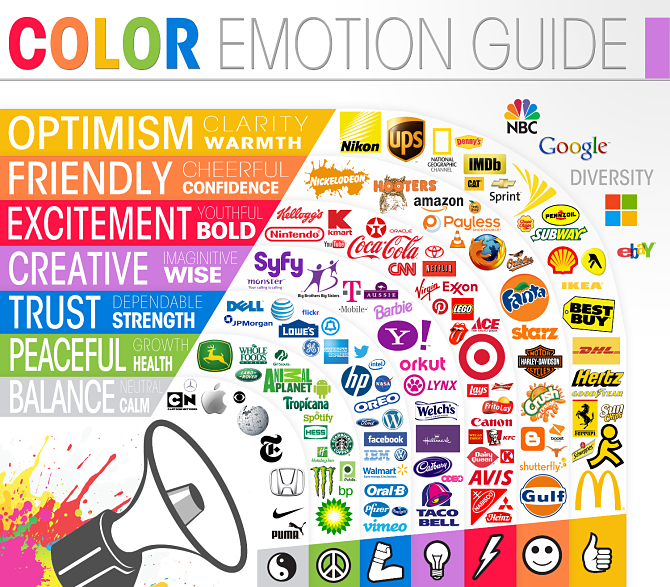
By playing on these ingrained mental associations, brands convey messages without even speaking or using text. Going a step further, today’s brands are leveraging visuals to an even greater degree, through the usage of augmented and virtual reality. These multidimensional, multimedia experiences are immersive and interactive, essentially providing your brain a visual high.
Our brains process images 60,000 times faster than text, so it’s no wonder marketers are emphasizing visuals across all mediums, from in-store displays to social media.
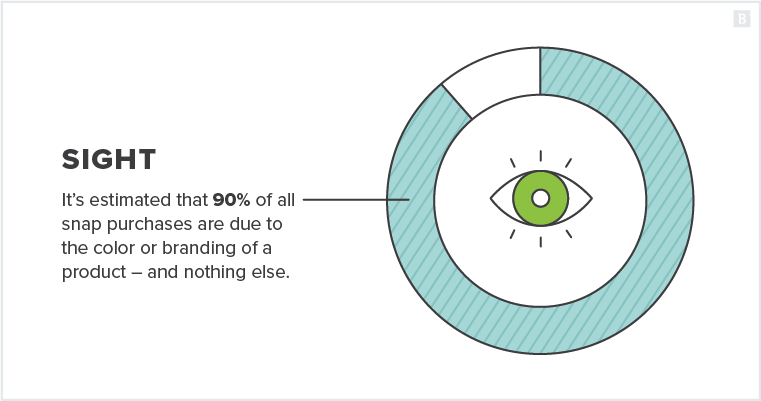
Smell
Remember walking through the mall and catching a whiff of super-pungent cologne before you even realized you were approaching Hollister?
Or how you can immediately identify the smell of cinnamon rolls in public squares like airports and subways? That’s because Cinnabon strategically sets up shop at locations that are more likely to catch and retain scents long after a cinnamon roll is cooked and sold. Cinnabon also bakes new batches every 30 minutes and will oftentimes just stick a pan of cinnamon in the oven so that it perpetually gives off its signature scent.
Customers, bystanders and pedestrians are trapped in these vacuums of sweet aromas, and where the nose goes, so does the wallet. That’s scent marketing in a nutshell.
By leading with a smell – which is closely tied to taste – a brand sets forth its best differentiator, one that is very primal and that humans are incredibly sensitive to. Research suggests that 75% of our feelings are conjured by odors, which makes sense because so much of the products we use and consume are scented, down to toothpicks and toilet paper. And you’re 100 times more likely to remember a smell compared with what you hear, see or touch.
How’s that for staying power?
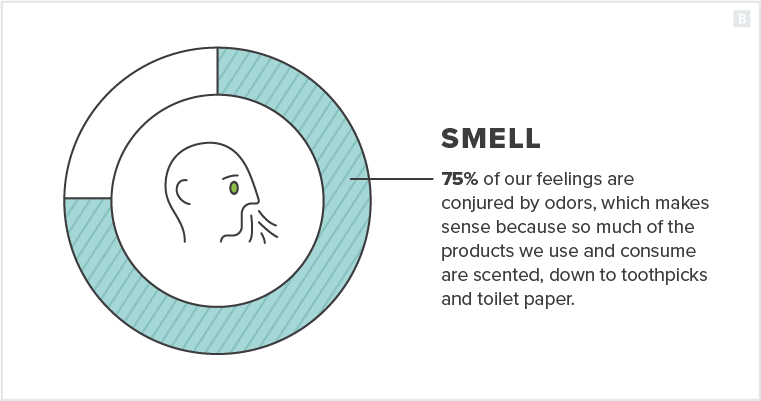
Touch
Laying a finger on something – an object or a person – builds a connection at a very basic level. Harvard Business Review found that when waitresses touched patrons – a light pat on the shoulder – they were tipped better. It creates an interpersonal relationship that didn’t exist before. The same applies to physical products.
Retail stores often display products outside of their boxes, allowing shoppers to grab, handle and experiment with devices. This is the business model for every electronics store.
Holding a product is closely correlated to purchasing a product, as shoppers have already cleared a hurdle in their decision-making process. They’ve triggered emotions of comfort, familiarity and calmness, and they associate those sentiments with consumer products.

We live in a world of touchscreens, and we treasure our smartphones and tablets like they are our children. We cradle them, keep them on our persons, sleep next to them – it’s all really philosophical, but also totally reflective of human relations to the world around us.
Brands want you to interact with their products, to create tactile sensations, to bond with objects based on how they make you feel, physically and emotionally. To touch is to be human, and that’s a marketing concept that’s easy to integrate into shopper campaigns.
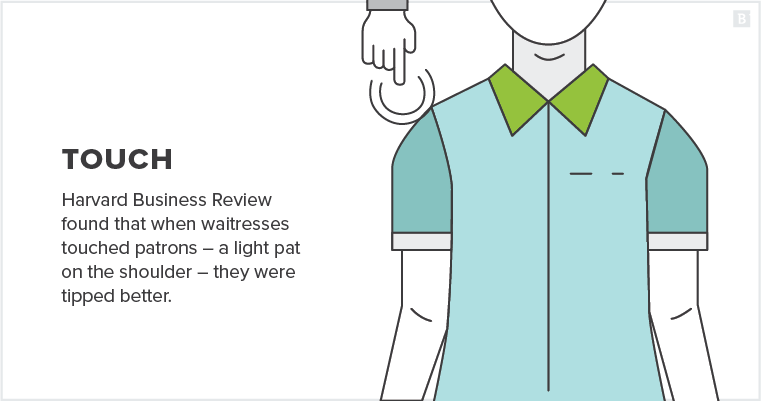
Taste
Who doesn’t love free samples? Following the same approach as touch marketing, food brands give away their products upfront. They want to create an immediate connection that’s savory to the tongue and solidified in the mind: This tastes amazing, and I have to buy it.
Taste is viewed as the most intimate of senses because it can only be experienced by ingestion. You can’t see or hear it from a distance. You have to engage and absorb food or drink to access taste. It’s also tougher to generalize, as each human has a unique taste profile based on their genes. This makes taste a bit more subjective, for both consumers and marketers.
There’s also the fact that taste does not always correlate to quality or price. McDonald’s french fries taste phenomenally – to me at least – yet they’re super cheap and not very good for you. Conversely, a steak dinner is going to be quite expensive, though the beef itself could be low quality.
This fact means taste marketers are less likely to rely on simple coupons or discounts to get people to purchase their food; they need to give some of it away first. Because taste is hit or miss, relative to other senses, the barrier to entry (a pleasant sensation) is higher.
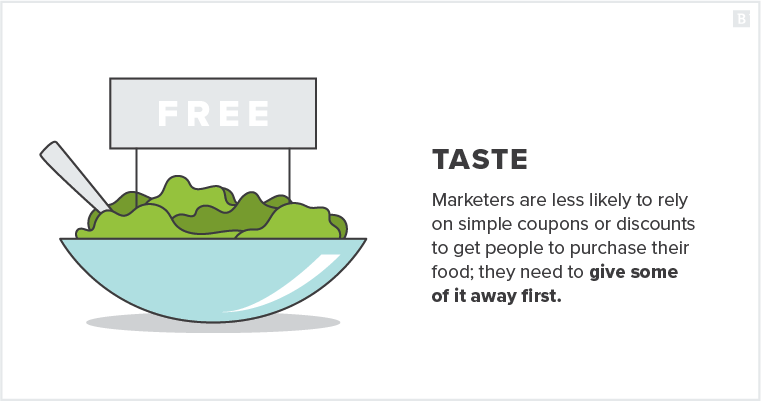
Hearing
Nearly 99% of all brand messaging conveyed to an audience is done via sound, which seems like a lot, but so much of it is subtle.
Retail outlets and coffee shops play music over the loudspeaker, inserting ads throughout. Radio, television, podcasts, music streaming, movie trailers, relaxation apps, voice assistants – they’re all auditory stimulators.
Jingles, taglines and sound effects comprise a vast portion of what we consume through media because these cues are optimized for listening with little to no effort.
I’ve never eaten Life cereal, but I know their “Mikey likes it” tagline. I’ve long since given up McDonald’s, but I’ll never be able to get “ba da ba ba ba, I’m lovin’ it” out of my head. Even now, I could sing acapella along with the Game of Thrones opening instrumental. These things stick with you, sometimes against your will.
It’s almost like these ears aren’t even our own.
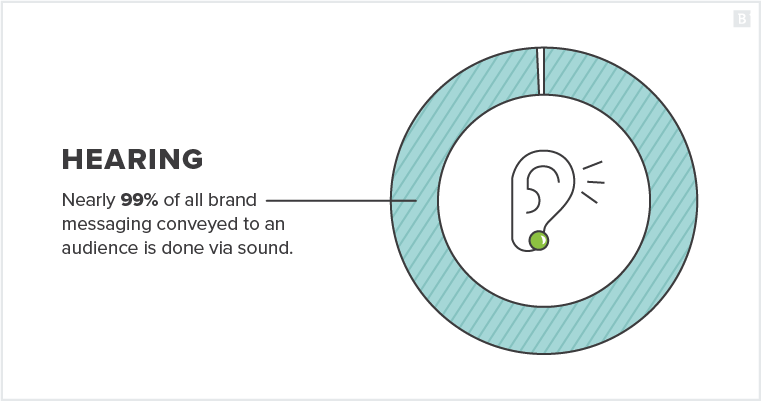
Our daily biases at work
As examined, the five senses prime us to purchase from brands, whether that’s to our benefit or not. After these initial connections, marketers also use various forms of bias to entice consumers to make additional decisions. Some of the most common are:
- Social proof: if a lot of other people bought something, then it must be good.
- In-group favoritism: believing people, ideas or items that belong to your in-group – social status, race, industry, etc. – are preferable to out-group alternatives.
- Groupthink: individuals’ desire for conformity in a group setting forces them – and the group – to think only one way, potentially leading to actions previously thought unlikely.
- Bandwagon effect: the overriding of individual beliefs to be part of growing trends.
- Confirmation bias: only intaking or relying on information that supports our existing views.
- Anchoring bias: relying too much on an initial bit of information (the anchor) and making subsequent decisions because of it.
Marketers use these biases to more strongly impress upon consumers why a purchase is needed. Featuring customer testimonials and reviews on websites does this. Providing referral codes to existing customers to share with their networks does this. Running user-generated content or hashtag campaigns does this. It’s all about building a trend that is self-serving, yet designed to seem organic or unbiased.
What’s a content marketer to do?
While our sensory abilities have existed since the dawn of humanity, how marketers capitalize on them changes over time. New technology, new demands and new media open up additional avenues for entertaining and enticing customers.
Consider how you can incorporate the following tactics into your 2019 marketing:
- A/B testing: to better understand what works and what doesn’t.
- Rewards programs: use confirmation bias and small perks to fuel loyalty and repeat business.
- Lots of visuals: our primary sense – vision – is begging for better, higher-quality photography, illustration and video.
- Negative space: don’t overload our line of sight with too much info.
- Nostalgia anchoring: root content in a nostalgic setting or idea, allowing consumers’ minds to chase after that thread of memories that follows.
- Multimedia: experiment with auditory and interactive content to stimulate additional/simultaneous senses at once.
Still have your head on straight after absorbing all of this info? Good, because you’re gonna need it. As you master of your branding and messaging, you should be able to see how the push and pull of senses and biases work in action – and to your benefit as a marketer.
It’s not quite a Jedi mind trick, but it’s close.





